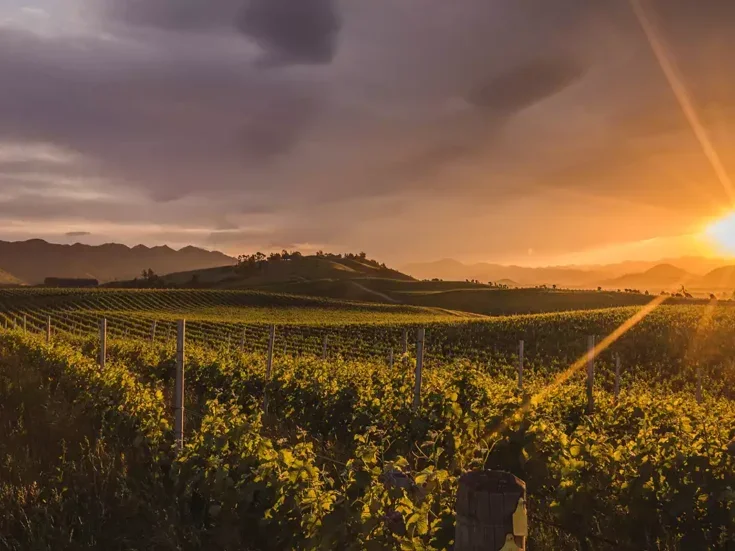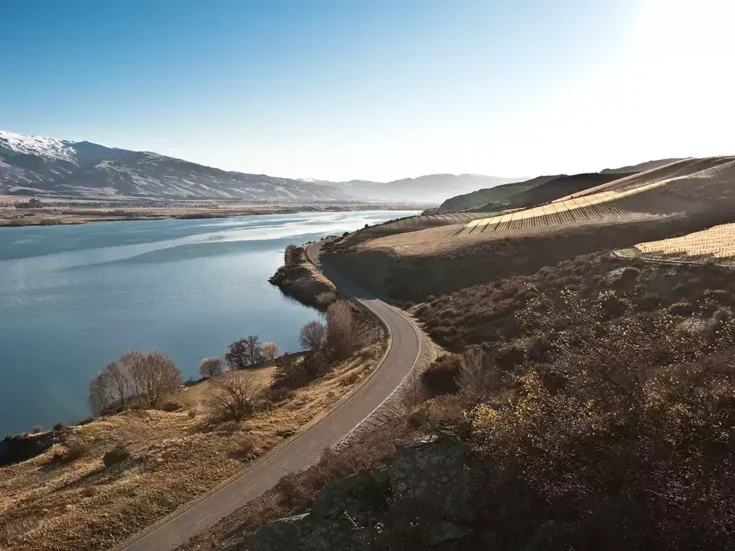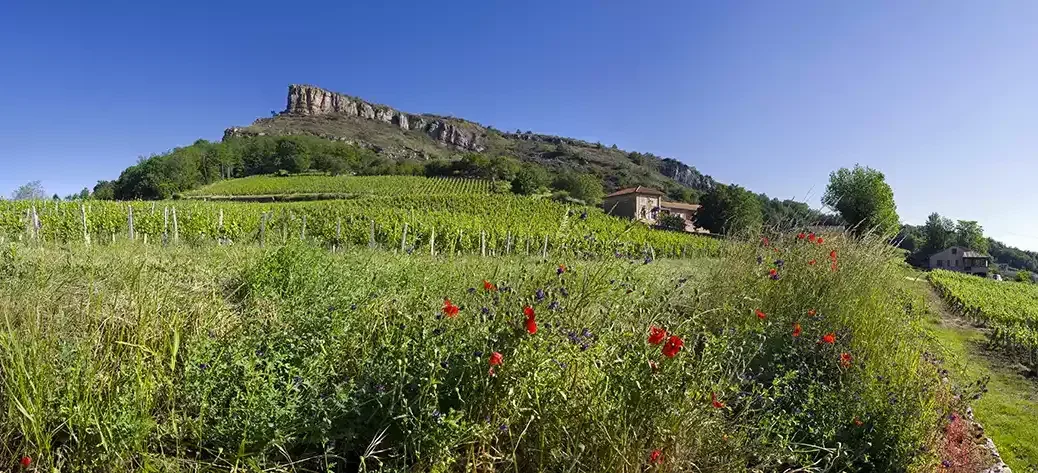
It was scorching in Pouilly-Fuissé when I arrived on a June afternoon. Frédéric Marc Burrier was waiting for me outside Château de Beauregard leaning against his 1967 Citroën DS station wagon. “Do you mind if we drive in this,” he asked. “It’s almost as old as me.”
Burrier spent 17 years as President of the growers’ union (Union des Producteurs de Pouilly-Fuissé), and is largely responsible for the creation of Pouilly-Fuissé’s 22 premiers crus which were ratified in 2020. I’d asked Burrier if we might tour the premiers crus together, allowing him to fill me in on the story and tell me about the climats he was so instrumental in raising from village to premier cru.
We set off across the rocky ground. The ride was surprisingly comfortable bouncing on the hydraulic suspension developed by Citroën for this classic motor. “There’s a bit of leakage from the system,” says Burrier ruefully, “but it’s a great family car. There are two seats in the trunk.”
There are 194ha (479 acres) of Pouilly-Fuissé premier cru scatted across four communes. The heartland of the region is Fuissé, a large village with an outsized church, which is flanked by slopes of premier cru. There are 51.35ha (127 acres) of premier cru in Fuissé. On the north side of the church these vineyards flow into those around the neighboring hamlet of Pouilly. However, Pouilly turns its back on Fuissé and links itself with Solutré, which doesn’t seem logical, but so little in Burgundy is. (Pouilly-Solutré has 71.73ha [177 acres] of premier cru).
Beyond the rock of Solutré there is a second rocky escapement where the vineyards and village of Vergisson are to be found. (Vergisson has 36.72ha [91 acres] of premier cru). Chaintré is the most southerly commune. It has 34ha (84 acres0 of premier cru and is isolated from the other villages and adjoins the hamlet of Vinzelles.
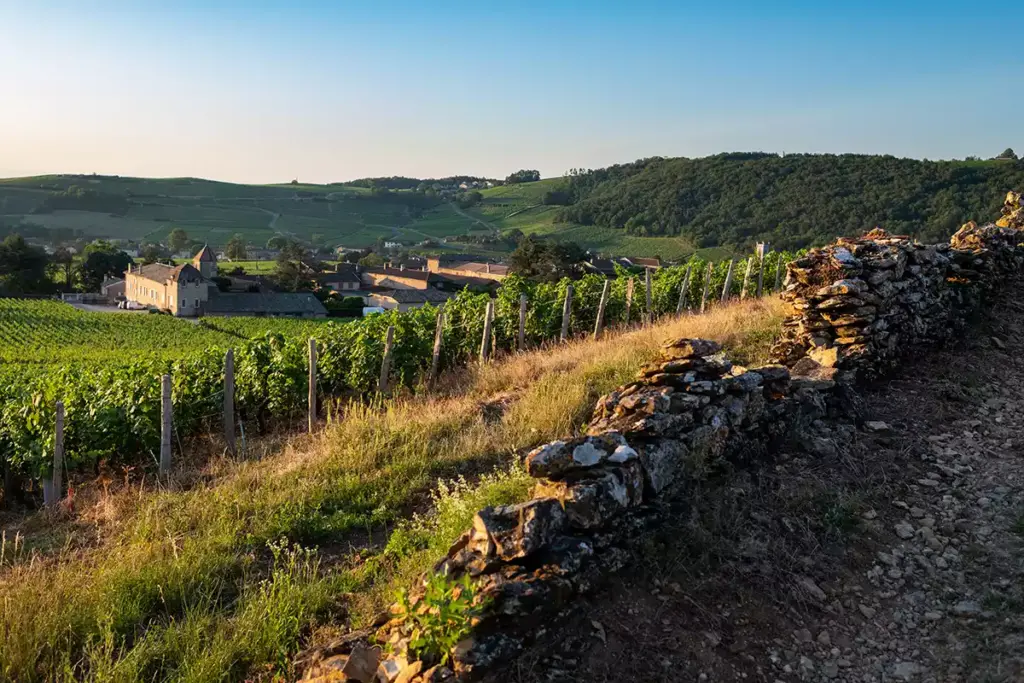
North to south from Chaintré
We headed south for Chaintré from where we would work our way back northwards. As we drove along Burrier described the lengthy process to gain premier cru status. “Step by step we got people to start talking about it from 2007 and then in 2010 applied for 24 crus. The INAO rejected two and ten were smaller than expected.” It took four years to establish the criteria by which the vineyards would be measured. The criteria were grouped into three categories: technical, “usage—local, loyal and constant,” and tasting. “The regulations within these had to be strict so no one could undermine them.” And there were other concerns. “People were anxious that raising some vineyards would seem to de-classify others.” L
The technical criteria included soil, aspect, inclination, and altitude. “The soil has to originate from the Jurassic period; from the Lias to the Oxfordian, 200 million to 150 million years old.” The altitude limitation, above which a premier cru would not be permitted, was set at 400m (1,310ft) above sea level. Any slope facing north or north-east was automatically excluded. However, an east-north-east slope might be included where there was a mitigating factor to offset the colder aspect, such as the incline.
We arrived in Chaintré and walked out to inspect the east facing slope where three of Chaintré’s premier cru are located; Chevrières (11.36 ha [28 acres] and Aux Quarts (11.22 ha [27.7 acres]) stretch along the upper section of the gentle slope which just about reaches 270m (886ft). Le Clos Reyssier (8.68ha [21 acres]) lies beneath them.
“Chaintré makes opulent wines. The biggest and fullest wines of Pouilly-Fuissé,” Burrier tells me. “It’s on an east-facing slope, so a traditional Côte d’Or set up.” There is a river in the valley below, which, Burrier says, moderates the temperature to some extent and it’s worth noting that part of Chevrières turns towards the west.
Chaintré premier cru Aux Quarts abuts the Vinzelles vineyards of Longeays and Les Quarts. (These vineyards will join the premier cru fold in 2024.) This is a logical extension to the premier cru classification given the vineyards continue along the slope at the same altitude and with very similar soils. (I’ll write about Vinzelles and Loché another time). However, it’s a little mystifying that Le Clos Reyssier, which is situated down slope on heavier soils, particularly at the bottom, is included in the premier cru bunch.
It seems that Le Clos Reyssier benefited from the “usage” criteria. In order for a vineyard to be elevated to premier cru status it was necessary to prove it had been in constant use. This could be demonstrated in a number of ways including sales records of bottles, production declarations, reviews in the press, and old labels. When I quizzed Burrier about Le Clos Reyssier he admitted that the lower section of this climat was really too deep for premier cru status, but there had been a strong case of “usage.”
Meanwhile over the brow of the hill in Chaintré, the climat called Le Clos de Monsieur Noly did not fare so well. Only 2.74ha (6.8 acres) of the 8ha (20 acres) put forward for this premier cru were actually approved. Some of the slopes are west-facing, but it’s a roly-poly climat and much of it fell foul of the strict rules regarding aspect. One can only imagine how disgruntled some vignerons might feel about this decision, as it diminishes the perceived quality of their parcels. It’s quite typical in the Côte d’Or for a climat to be separated into village and premier cru level and for both to use the climat name, but this is not permitted in Pouilly-Fuissé. The sections which failed to make the grade lost the right to use their climat name. Hence forth the wine could only be labelled as Pouilly-Fuissé.
Outcrops of granite
Leaving Chaintré we drove north alongside a wooded area towards Fuissé. I’d already come along this road in the morning with the delightful Jean-Philippe Bret who had also given me a tour of the region. Two in one day! However, Bret had taken a left and driven a short way along the road to visit Château de Rontets where three cuvées are made from the large vineyard of Les Rontets.
This vineyard is situated on a high and windy plateau. It gets sunshine all day long and fulfils the criteria for soil but is too high to qualify as a premier cru. “Don’t disregard village level,” says Bret. “It doesn’t mean the place cannot make really good wine.” I couldn’t agree more. Former architects, husband and wife team Fabio Montrasi and Claire Gazeau, make some super wines from Les Rontets.
If you stand near Rontets facing south, you look straight into Beaujolais. Hence it should be no surprise that there are outcrops of granite in Pouilly-Fuissé. All the land surrounding me at that point, with the exception of an isolated area of limestone, is granite.
During the premier cru project, numerous holes were dug and soil samples analyzed as part of the process of studying the geology of Pouilly-Fuissé; something which the region had to self-fund. “The key criterion for the classification was the Jurassic soils,” remarks Burrier. “They may have more or less topsoil, but the limestone, particularly Bajocian, mixed with clay, was all important. The two cliffs are made of hard Bajocian limestone. The same as the Mont-Rachet. However, there are quite a number of younger (Miocene) or older (Trias) soils all over the appellation.”
By now we had driven past the wood and were looking over to the east-facing slope which lies either side of Fuissé village, which I mentioned earlier. In the vineyards behind us the soils are volcanic and classified as Mâcon. “The Chardonnay on these granite/schistous soils is lighter-structured and not as perfumed as the wine from limestone and clay,” remarks Burrier.
“It was important that the 799ha (1,974 acres) of Pouilly-Fuissé, delimited in 1922 and ratified by the INAO in 1937, was not extended as a result of the premier cru process. It was not an exercise to uplift regional classifications to Pouilly-Fuissé.” (Currently there are 760ha [1,878 acres]) in production of the total 799ha, due to crop rotation.)
We paused to look across at the vineyards on the slope. “Fuissé is the heartland of Pouilly-Fuissé. If there will ever be grand cru, they will be here,” observed Burrier who says the premier cru from the Fuissé commune are “not as big as Chaintré nor as mineral as Vergisson, but the most profound.”
To the left (or south) of Fuissé village lies the premier cru Perrières (5.79ha [14.3 acres]). “Perrières produces wines which are strict and precise.” I’d agree and point you in the direction of JA Ferret who make a straight and salty wine for this climat. Within Perrières the slope creases into a central fold, where the wines are not as good, and which is classified as Mâcon-Fuissé. This illustrates Burrier’s remark that regional wines should not be upgraded in the wake of premier cru. This part retains its regional status.
Adjacent to Perrières is the large 19.13ha (47.3 acres) premier cru Les Vignes-Blanches which Burrier describes as very marly. “It producers elegant, but not very structured wine.” Here the slope is 20-25 degrees. Standing in the vineyard it certainly felt steeper than it appeared from across the valley. I find the style of Vignes-Blanches smoothly delicate. It can easily be overoaked and lose its elegance.
Neighboring Le Clos is a monopole belonging to Château Fuissé. Burrier says it’s questionable if the lowest section, where the soils change, should have been included as premier cru. However, this part represented less than 15% of the climat so it passed through. This walled clos makes rich, rounded, and, in a warm vintage, opulent wine, but with welcome firmness to the structure and sapidity to the finish.
The tiny 0.83ha (2.03 acres) Les Brûlés is more south-facing. As we drove by Burrier remarked that it gets pretty hot and has a predominantly limestone soil. It’s a monopole of Château Fuissé.
Les Ménétrières (5.22 ha [12.9 acres]) has the highest proportion of clay among the Fuissé premier cru. “It has rich and deep clay and the slope turns from east to a little more south-east. It makes the most structured wine,” says Burrier. I find Ménétrières full-bodied and robust with quite a ferrous sensation.
The neighboring premier cru Les Reisses (4.13 ha [10.2 acres]) has also been known as Vers Pouilly, but the historical name was settled on in the premier cru process. “It turns slightly towards the north-east and makes more elegant wines,” remarks Burrier.
Searching for chailles
Directly over the commune boundary into Solutré-Pouilly lie the premier cru vineyards of Aux Chailloux (6.74 ha [16.65 acres] and Aux Bouthières (4.86 ha [12 acres]). It’s clear from the terroir map and from the name “Chailloux” that the soil changes here to a non-calcareous clay with trace elements of chailles. Chailles originates from limestone and is composed of crystalline siliceous elements, mainly quartz. “Chailles are pure siliceous stones,” remarks Burrier. “Originally, they were a sort of cement between the layers of limestone, but the limestone slowly disappeared, dissolved into the water in the soil. Only the chailles remained, which are not soluble in water.”
There is no limestone in these vineyards and the orientation changes to become more south-facing. When I passed them earlier in the day with Jean-Philippe Bret, he told me that these are good places in dry summers as the vines never stress in the deep soils.
Burrier describes the wines as “Rich and opulent, but not lacking in elegance because the drainage is excellent due to the quantity of chailles.”
The BIVB have published a useful Carte de l‘Appellation for Pouilly-Fuisseé which defines the different soil types. Consulting this map later there appear to be outcrops of chailles within the premier crus of Les Vignes Blanches and Perrières. I followed up with Burrier who responded “Some lieux-dits in Les Vignes Blanches like Les Châtaigniers are made with chailles. Les Perrières has a few chailles areas too.”
Moving on to the extensive premier cru vineyard of Pouilly (19.37 ha [47.9 acres]). This is covered by a stony scree forming the visible top layer—similar to Les Perrières and Les Vignes Blanches. Burrier is co-owner and sole farmer of Château du Clos in Pouilly. “This is a clos of 3ha (7.4 acres) including 2ha (5 acres) of premier cru Pouilly. The culture has been organic here since 2009 and the winemaking is the same as Beauregard. Pouilly is the real heart of the appellation, where everything started with Chardonnay in the 18th century. Here the soils of scree and brown clay on calcareous marls give outstanding white Burgundies.”
Straddling the communes of Fuissé and Solutré-Pouilly is Vers Cras. This is a surprisingly flat place, fractionally east-facing with Château de Beauregard located right in the middle. Burrier describes this as a “big plate of Jurassic limestone with a high percentage of active limestone. Vers Cras is made of Oxfordian superior limestone (coralian). That’s the younger Jurassic soil of the AOP. Due to the poor and stony calcareous soils, which is very thin (sometime only 50cm [20 inches] deep), the style of the Vers Cras is not opulent. It is the opposite of the usual image of rich and solar Pouilly-Fuissé. We can describe a style of nice intensity and saltiness, elegant and precise, able to age well.”
Vers Cras (9.63ha [23.8 acres]) clearly gets plenty of sunshine, although a small section tips marginally to the north and this was excluded from the premier cru. Towards the end of the premier cru process there was a public consultation which allowed individuals to challenge the INAO’s proposed demarcation. “Two months during which the INAO studied each case in the field to make a final decision,” recalls Burrier, which increased the premier cru area from 183ha (452 acres) to 194ha (479 acres0. In the final analysis only three of the 365 producers dissented from the INAO’s decision and one of these was over a 0.1ha (0.247 acres) parcel.
At the bottom of the rock
I began to feel somewhat car sick as the Citroën wiggled through Pouilly and loped around corners towards Solutré while I scribbled everything Burrier was telling me into my notebook. So it was a relief to reach the bottom of the rock and pause to speak about the premier cru of Au Vignerais and the tasting element of the premier cru “stress test.”
For the tasting it was decided to collate bottles of the 2013 vintage, which was the most widely available vintage at the time. The wine was tasted blind by enologists, producers, and brokers from outside the region. However ,it proved very difficult to find wine from Au Vignerais despite its size (18.6 ha [46 acres]). Burrier explained that most of the production was traditionally sold in juice to négociants, which disappeared into blends. This created a problem in sourcing wine bottled and labelled “Au Vignerais.” It also called into question the vineyard’s legitimacy as “loyal and constant” for there were no sales records or press reviews. However, it met the technical criteria and ultimately this couldn’t be ignored. Common sense prevailed and Au Vignerais was accepted into the premier cru fold.
It drapes across a south-facing slope. Jean-Phillippe Bret, who has a parcel here, remarks, “I love Au Vignerais in 2021, but when it’s very ripe it’s too large as it’s south-facing. It becomes a caricature.” Based on my tasting I’d agree. In a hot vintage such as 2022 it’s pretty rich and lacks the firm structure to underpin this. However, in a cooler vintage it is delicious and well balanced. Domaine La Soufrandière Pouilly-Fuissé Premier Cru Au Vignerais 2021 is ripe, juicy, and energetic with mouthwatering sweetness and plenty of acidity to finish.
I asked Burrier to sum up the premiers crus from the Solutré slopes, which include En Servy (3.99 ha [9.9 acres]), La Frérie (4.08 ha [10.1 acres]), and Le Clos de Solutré (4.4ha [10.9 acres]). “They are very harmonious. The wines are not as extreme as Vergisson or Chaintré, but they lack for nothing.”
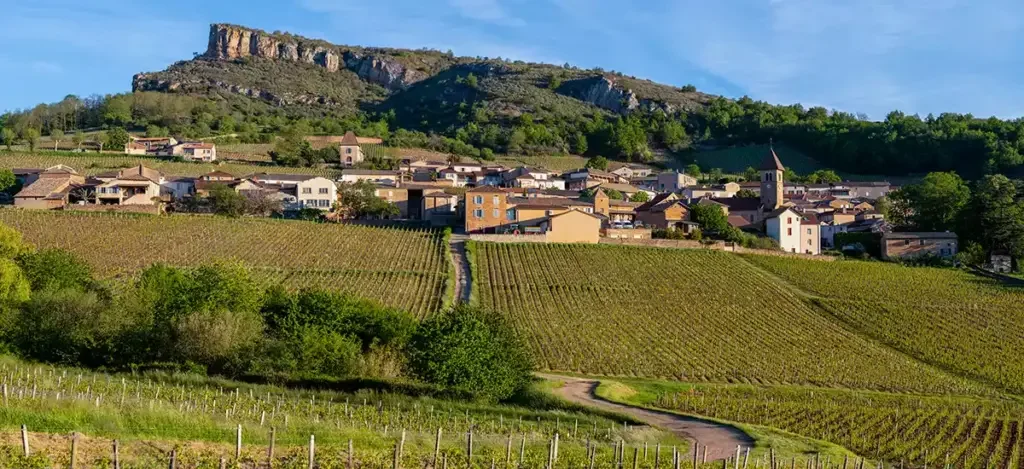
We motored on past the rock of Solutré and entered the prettiest of valleys. Vergisson lies between the two rocks and embraces the delightful village. Here it feels secluded, rural, and lost in time. Far from the city and the commercial river, the link with medieval Burgundy is strongest here. It is very different from Chaintré where it is possible to see the urban sprawl of Mâcon; and sadly in Loché, huge industrial estates, factory buildings, and warehousing, are encroaching on the village.
Vergisson has the coolest climate within Pouilly-Fuissé and until relatively recently, was considered the least interesting commune when the market favoured the rich, opulent (and oaky), style of Pouilly-Fuissé. However, Vergisson has benefited from warmer summers and from growing appreciation for the more mineral, straighter style of Pouilly-Fuissé it produces.
Vergission also has the greatest diurnal shift and the coldest nights which keeps the acidity bright and energy lively. “Most of the land is owned by the village and rented to the growers. It’s the most extreme place, but Chardonnay is very happy here. The producers suffered in the past as the quality was not considered to be so high,” Burrier remarks.
These days the wines, which are the most mineral and precise among the communes, are highly sought after and there are talented producers with small domaines, among them Domaine Gilles Morat and Domaine Saumaize Michelin, who do a great job of expressing the terroir.
There are vineyards on many slopes and aspects of the Vergisson hill, including the cold flank of the Loché rock, but the premier cru vineyards are confined to the warmest slope. There are three principal vineyards, Les Crays, La Maréchaude, and Sur La Roche. They step up the slope with Sur La Roche at the top.
There are a couple of small and isolated parcels called En France (1.87 ha [4.6 acres]). These are outliers. “Only a very small part of En France was accepted. The part which is on Jurassic soils,” says Burrier. “The main part of En France, together with Aux Charmes and Ronchevat is on soils from the Trias and was rejected. Aux Charmes was also one of the 24 candidates at the very beginning but was refused for the same reason.”
Let’s consider the three significant premiers crus. La Maréchaude (9.34 ha [23.1 acres]) lies on the lower section of the slope, which nestles in the valley and is hidden by village houses if you try and spot it from the far side of the valley. The soils here are the deepest and the style of wine it produces is the roundest, or as Burrier puts it, “Maréchaude has the most solar expression of Vergisson.”
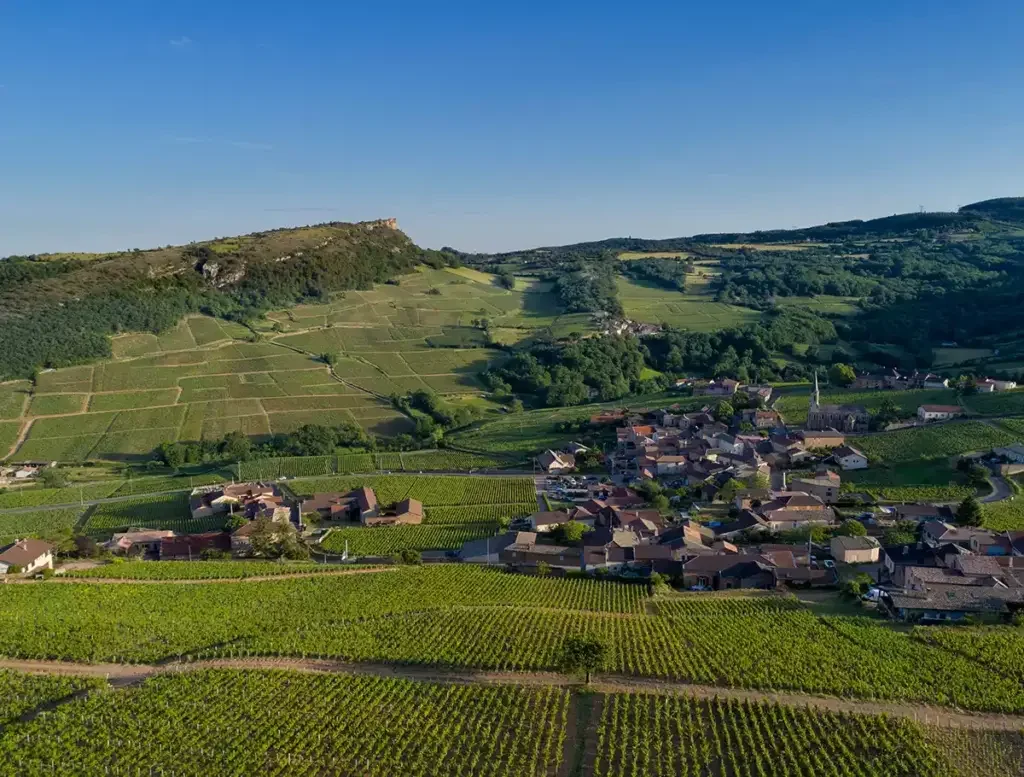
Les Crays (10.75 ha [26.6 acres]) is a steep and sunny slope where the vines at the top seem to disappear into the rock, planted into the cliff face. The soil is stony. This slope catches the sun, and the wines are ripely fruity, but super mineral. “There is a lot of scree here. The vines go up to 400m [1,310ft] and the wines have a very mineral character,” remarks Burrier who has a smidgen of Les Crays sufficient for two barrels.
When I passed by earlier with Jean-Philippe Bret, we stopped to speak with a vigneron working on a slope so steep it would be difficult to walk up let alone manage a vineyard. The man was spraying his vines by hand from a bulky wheeled contraption. Just consider the time-consuming and arduous hand work involved in looking after vines in Les Crays, so much harder than a vineyard on a gentle incline or, as in Vers Cras, practically flat. In the light of this, the price of a bottle from Les Crays, and a few other equally steep slopes, seems very reasonable for the combination of labour and quality. This is a good moment to mention that from 2027 premier cru Pouilly-Fuissé must be harvested by hand and no herbicides will be permitted.
The premier cru of Sur La Roche (14.76 ha [36.5 acres]) is higher, but further around the hill with an east-to-south exposure. It’s very stony here with minimal topsoil and the wines it produces are the straightest and most cuttingly mineral. They are very stylish and savoury.
The top 5ha (12.4 acres), from 400-450m (1,410–1,480), were excluded from the premier cru. They were deemed too high and there was no aspect to compensate as this section is pretty much a plateau. However, the producers in this climat fared somewhat better than some, as these 5ha may be declared as Pouilly-Fuissé, Haut de La Roche. Even in the warm 2022 vintages La Roche turns out racy and salty wines.
Considering climate change
I asked Burrier whether climate change was taken into consideration when drawing up the technical criteria, after all the process took over a decade. Sites which were difficult to ripen because they were too high or had a slightly colder aspect are now benefiting from a longer, warmer season. Apparently not. It was deemed to be too difficult, and it was felt these sites would still produce inferior wines in cooler vintages. I think it’s a shame that such a comprehensive study couldn’t have incorporated a longer sighted vision into the creation of the premier cru. So don’t ignore some de-selected parts of climats.
And keep an eye open for vineyards which fit the bill for soil but were not even proposed on the basis of topography and microclimate. These can offer great value and an edgy style. In the morning I’d visited En Chatenay. The is a colder site under the wood on the wrong side of the Vergission rock where Bret and Dominique Lafon have neighbouring on the calcareous clay. “This shouldn’t become a premier cru, but it’s a great place in hotter summers,” says Bret. “Working here you are surrounded by nature – the woods and the birds. It has a natural energy.” Even in the challenging 2021 vintage I like Soufrandière Pouilly-Fuisse En Chatenay; a light, straight wine with fennel character. It is tart, sappy, and very lively and no doubt turbo-boosted by Bret’s excellent biodynamic viticulture.
The premier cru classification has stimulated greater demand for the upgraded Pouilly-Fuissé climats. Let’s hope prices do not follow suit. Bear in mind, as ever in Burgundy, it is the terroir which is classified, not the wine. Burrier says his 2021s sold out on release, which has never happened before.
It’s quite right that higher quality terroir should be recognised within the appellation system, but it’s a herculean task to get this through the INAO. Burrier accomplished a considerable feat in mobilizing the Pouilly-Fuissé producers to collaborate and should be proud that most of the best terroir is now delimited. Burrier admits the classification is not perfect, but as Jean-Philippe Bret surmises, “It’s a job 80% well done.” It seems likely there will be a second round of premier cru applications, but Burrier has moved on. He has his sights set on Pinot Noir.

